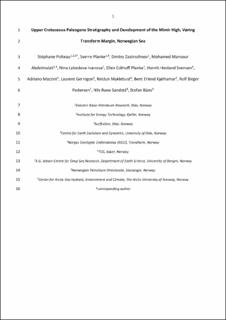Upper cretaceous-paleogene stratigraphy and development of the Mímir High, Vøring transform margin, Norwegian Sea
Polteau, Stephane; Planke, Sverre; Zastrozhnov, Dmitrii; Abdelmalak, Mohamed Mansour; Lebedeva-Ivanova, Nina; Eckhoff Planke, Ellen; Svensen, Henrik; Mazzini, Adriano; Gernigon, Laurent; Myklebust, Reidun; Kjølhamar, Bent; Pedersen, Rolf B.; Sandstå, Nils Rune; Bünz, Stefan
Journal article, Peer reviewed
Accepted version
Permanent lenke
https://hdl.handle.net/11250/2764697Utgivelsesdato
2020Metadata
Vis full innførselSamlinger
- Department of Earth Science [1050]
- Registrations from Cristin [9791]
Sammendrag
Transform margins represent strike-slip type of plate boundaries that form during continental breakup and initial ocean opening. They are often characterized by margin-parallel highs with exposed pre- and syn-rift sequences. The Vøring Transform Margin, offshore mid-Norway, initiated in the earliest Eocene during the opening of the NE Atlantic. Here, 2D seismic reflection data reveal a transform margin high, the Mímir High. The western flank of this undrilled structure is a kilometer-high escarpment where seismic reflections of pre-breakup age are truncated at the seafloor. The aim of this study was to recover seabed rock samples from the outcropping or shallowly buried sedimentary sequences to provide a geological tie to the regional seismic framework, thereby constraining the basin history and tectono-stratigraphic development. Seabed samples were successfully collected from 14 gravity core and Selcore stations and 10 ROV (remotely operated vehicle) sites along a 750 m high sampling profile, recovering clay, shales, sandstones and glacial dropstones. Biostratigraphy results revealed that the ages of the sedimentary rocks follow the stratigraphic order predicted by the initial seismic interpretation, with Upper Cretaceous sediments at the base and lower Eocene sediments at the top. The integrated interpretation shows that the Mímir High area, including parts of the outer Vøring and Møre basins and the proto-Jan Mayen Microplate Complex, were characterized by the deposition of late Campanian to early Maastrichtian, near coastal and shale-dominated sequences with poor source rock qualities. The early Paleocene samples indicate deep marine conditions that abruptly ended by rapid uplift of the Mímir High in the earliest Eocene. Finally, a reworked Pliensbachian palynomorph assemblage in potential early Eocene strata indicate the presence of exposed Mesozoic sequences in the vicinity of the Mímir High. We argue that some of the lower Eocene sediments where deposited within a hypothetical drainage system sourced from Greenland (Traill Ø or Jameson Land) and/or from the Jan Mayen Ridge prior to continental separation, and not the result of recent ice-rafting.

